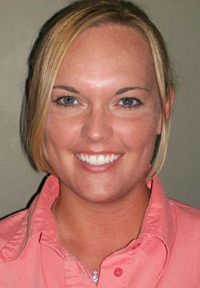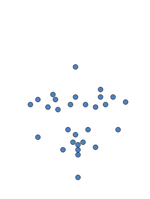 |
Kendra Schmid, Ph.D. |
Using a computer model composed of guidelines proposed by Leonardo da Vinci in the Renaissance era for drawing beautiful pictures also known as neoclassical canons, along with the golden ratio of approximately 1.62 and symmetry measurements, Kendra Schmid, Ph.D., assistant professor of biostatistics in the College of Public Health, can calculate perceived attractiveness within approximately half a point.
Dr. Schmid recently did so for the Democratic and Republican presidential candidates. She uploaded photos of McCain and Obama onto her computer, performed a series of clicks on their faces — starting with the pupils and ending with the chin — and pressed compute.
The Web site HotorNot.com ranked Barack Obama an 8.9 on a one-to-10 scale out of 14,540 votes. John McCain was a 5.2 out of 14,485 votes.
On this day, however, Dr. Schmid got different results. Obama scored .03 less than McCain in the looks department.
But, Dr. Schmid said, in other tests using different photos of the two candidates, Obama typically averages a half a point higher than McCain.
The ratings vary depending on the photos and preciseness of the clicks, but Dr. Schmid said her formula for figuring attractiveness is much more accurate than hotornot.com.
“This is based on measurements, so there’s some merit to it,” she said. “On the Hot or Not Web site, you can inflate your own rating by voting several times.”
Dr. Schmid’s models for attractiveness measurement were developed from a research study featured in last month’s Pattern Recognition magazine, in which volunteers rated nearly 500 face images. Dr. Schmid is the lead author of the article, with University of Nebraska-Lincoln professors David Marx, Ph.D., and Ashok Samal, Ph.D., serving as co-authors.
One thing that separates Dr. Schmid’s study from other attractiveness studies in the past is the use of actual faces as opposed to altered composite images.
“We used real people,” she said, “but we also included famous faces to see if the computer model gave higher scores to faces deemed attractive by society.”
Turns out it did. Most famous faces rated between 7.5 and 8.5, while the majority of non-famous faces rated between 5 and 6. Obama averages a 7 and McCain a 6.5. There were no 10s awarded, but one celebrity was close.
“Brad Pitt rated a 9.3, which I think we already knew,” Dr. Schmid joked.
The images included only straight-on shots of the face, both ears showing, mouth closed and no visible expression.
“It throws off the measurements if someone is smiling, so images with no expressions help minimize variability,” Dr. Schmid said, though she agreed a happy face can influence a person’s attractiveness.
“However, when you take away the face and just have the dots, the computer doesn’t know if the person is smiling or angry.”
Previous studies indicate that symmetry plays a major role in determining attractiveness — however — it does not play as important a role in perceived attractiveness as the proportions defined by the neoclassical canons and golden ratios, Dr. Schmid found.
“Most people are generally symmetric,” she said. “Our model goes beyond symmetry.”
 |
 |
The dots shown in these pictures illustrate the method Dr. Schmid uses to determine facial attractiveness. She says key factors in attractiveness are symmetry of the upper tips of the lip, equal distances of the eyes and between the eyes and a mouth width about 1.6 times nose width |
While there, the North Platte native studied face recognition and image processing related to terrorism studies by matching images from cameras to mug shots.
Some of her more interesting findings from her facial attractiveness study include:
- Men gave higher ratings overall;
- Males rate themselves higher than females, scoring themselves an average of 6.8, while females average 6.0;
- Male raters prefer a more slender face and/or smaller nose;
- Female raters view a smaller chin and/or larger distance between the eyes as more attractive;
- Female faces are viewed as more attractive when they have smaller noses and/or a larger distance between their eyes;
- When given the option to rate themselves, the higher raters scored themselves, the more attractive they found others; and
- For each additional second a female spent looking at a face, the rating decreased, while the opposite was true for males. The longer they looked at an image, the more they liked it.
Dr. Schmid isn’t sure what most of the results may mean. She’s a statistician and asking her to qualify something is like asking artists to quantify their work.
“One may say that because men gave higher ratings overall that they are less critical than women, but I don’t know,” Dr. Schmid said.
Asked if she’s ever analyzed her own attractiveness, Dr. Schmid responded with a resounding “no.” She’s not even the least bit curious.
“I’d be worried my mouth would be only 1.5 times the width of my nose, not 1.62,” she said, laughing. “Plus, I don’t want to know.”
Though she doesn’t want to use her own picture, Dr. Schmid would like to expand and make her model more generalized to include people of all cultures. She hopes that her program could possibly be used as a guideline for reconstructive plastic surgery after car accidents or, on a lighter note, online dating where people are introduced to others with similar ratings. However, she does not believe her model should determine the next president.
“I think it would be interesting to use it on past elections and see if the more attractive candidates were winners,” she said, “but I would hope that people vote on the issues and not on attractiveness.”